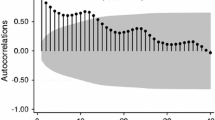Abstract
Short-term forecasts of container throughput are essential for planning both port operations and hinterland activities. However, the volatility and uncertainty in global economic activity and, consequently, in seaborne trade introduce complexity in modelling and forecasting container throughput at the port level. In this article, different univariate time series approaches were applied; the autoregressive integrated moving average (ARIMA) model, namely the ARIMA-intervention model, and the ARIMAX model with leading economic indicator. The advantage of the methodology applied is two-fold; (i) it provides insight about the data generating process post-2008 financial crisis and (ii) it identifies the relationship between economic activity and container throughput. Monthly data for the total container throughput at the port of Antwerp was used for the period January 1995–March 2015. On the basis of the empirical analysis and the assessment of the forecasting performance, the EU industrial confidence indicator turned out to lead the container throughput for 2 months. In addition, the incorporation of the structural break of October 2008 showed that, given the conditions, container throughput was persistent to return to the pre-crisis level.




Similar content being viewed by others
References
Box, G.E.P., Jenkins, G.M. and Reinsel, G.C. (1976) Time Series Analysis: Forecasting and Control. Oakland, California: Holden-Day.
Box, G.E.P and Tiao, G.C. (1975) Intervention analysis with applications to economic and environmental problems. Journal of the American Statistical Association 70(349): 70–79.
Chatfield, C. (2004) The Analysis of Time Series: An Introduction, 6th edn. Boca Raton, London, New York, Washington DC: CRC Press.
Chung, R.C.P., Ip, W.H. and Chan, S.L. (2009) An ARIMA-intervention analysis model for the financial crisis in China’s manufacturing industry. International Journal of Engineering Business Management 1(1): 15–18.
Coppens, F. et al (2007) Economic Impact of Port Activity: A disaggregate Analysis-The Case of Antwerp. National Bank of Belgium Working Paper no. 110.
De Langen, P.W. (2003) Forecasting container throughput: A method and implications for port planning. Journal of International Logistics and Trade 1(1): 29–39.
Eurostat. (2015) The industrial confidence indicator, http://ec.europa.eu/eurostat/tgm/refreshTableAction.do?tab=table&pcode=teibs020&language=en, accessed 5 June 2015.
Fox, A.J. (1972) Outliers in time series. Journal of the Royal Statistical Society. Series B (Methodological) 34(3): 350–363.
Franses, P.H. (1998) Time Series Models for Business and Economic Forecasting. Cambridge, UK: Cambridge University Press.
Fung, M.K. (2002) Forecasting Hong Kong’s container throughput: An error-correction model. Journal of Forecasting 21(1): 69–80.
Gröger, J.P., Missong, M. and Rountree, R.A. (2011) Analyses of interventions and structural breaks in marine and fisheries time series: Detection of shifts using iterative methods. Ecological Indicators 11(5): 1084–1092.
Hui, E.C.M., Seabrooke, W. and Wong, G.K.C. (2004) Forecasting cargo throughput for the Port of Hong Kong: error correction model approach. Journal of Urban Planning and Development 130(4): 195–203.
Klein, A. (1996) Forecasting the Antwerp maritime traffic flows using transformations and intervention models. Journal of Forecasting 15(5): 395–412.
Lai, S.L. and Lu, W.-L. (2005) Impact analysis of September 11 on air travel demand in the USA. Journal of Air Transport Management 11(6): 455–458.
Meersman, H., Moglia, F. and Van de Voorde, E. (2002) Forecasting potential throughput. In: W. Winkelmans, H. Meersman, E. Van de Voorde, E. Van Hooydonk, A. Verbeke and M. Huybrecht (eds.) Port Competitiveness: An Economic and Legal Analysis of the Factors Determining the Competitiveness of Seaports. Antwerp, Belgium: De Boeck Limited, pp. 35–66.
Meersman, H. and Van de Voorde, E. (2013) The relationship between economic activity and freight transport. In: M. Ben Akiva, H. Meersman and E. Van De Voorde (eds.) Freight Transport Modelling. UK: Emerald Group Publishing, Chapter 2 pp. 17–43.
Meersman, H., Van de Voorde, E. and Janssens, S. (2003) Port throughput and international trade: Have port authorities any degrees of freedom left? In: R. Loyen, E. Buyst and G. Davis (eds.) Struggling for Leadership: Antwerp-Rotterdam Port Competition between 1870–2000. Germany: Physica-Verlag, pp. 91–113.
Melard, G. (1981) On an alternative model for intervention analysis. Technical Report ULB-Universite Libre de Bruxelles, Belgium.
Pallis, A.A. and De Langen, P.W. (2010) Seaports and the structural implications of the economic crisis. Research in Transportation Economics 27(1): 10–18.
Peng, W.-Y. and Chu, C.-W. (2009) A comparison of univariate methods for forecasting container throughput volumes. Mathematical and Computer Modelling 50(7): 1045–1057.
Pindyck, R.S. and Rubinfeld, D.L. (1997) Econometric Models and Economic Forecasts. New York: Irwin/McGraw-Hill.
Rashed, Y., Meersman, H., Van de Voorde, E. and Vanelslander, T. (2013) A Univariate Analysis: Short-term Forecasts of Container Throughput in the Port of Antwerp. Antwerp, Belgium: Faculty of Applied Economics, University of Antwerp No. D/2013/1169/022, www.ua.ac.be/tew.
Slack, B. (2010) Battening down the hatches: How should the maritime industries weather the financial tsunami. Research in Transportation Economics 27(1): 4–9.
Tsay, R.S. (1986) Time series model specification in the presence of outliers. Journal of the American Statistical Association 81(393): 132–141.
Tsay, R.S. (1988) Outliers, level shifts, and variance changes in time series. Journal of Forecasting 7(1): 1–20.
Van Nieuwenhove, F. (2015) Economic importance of the Belgian Ports: Flemish maritime ports, Liége port complex and the port of Brussels. National Bank of Belgium 283.
Veenstra, A.W. and Haralambides, H.E. (2001) Multivariate autoregressive models for forecasting seaborne trade flows. Transportation Research Part E: Logistics and Transportation Review 37(4): 311–319.
Verbeek, M. (2008) A Guide to Modern Econometrics, 3rd edn. UK: John Wiley & Sons Ltd.
Acknowledgements
The authors would like to thank Dr Christa Sys and the BNP Paribas Fortis Chair on Transport, Logistics and Ports at the University of Antwerp for the financial support of this research, as well as the Port of Antwerp Authority for providing the data. Equally, the authors thank the MEL reviewers for the helpful comments they provided.
Author information
Authors and Affiliations
Corresponding author
Rights and permissions
About this article
Cite this article
Rashed, Y., Meersman, H., Van de Voorde, E. et al. Short-term forecast of container throughout: An ARIMA-intervention model for the port of Antwerp. Marit Econ Logist 19, 749–764 (2017). https://doi.org/10.1057/mel.2016.8
Published:
Issue Date:
DOI: https://doi.org/10.1057/mel.2016.8




